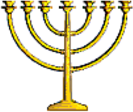Portal:Judaism/Weekly Torah portion/Bamidbar

In the wilderness, in the second month of in the second year following the Exodus from Egypt, God directed Moses to take a census of the Israelite men age 20 years and up, “all those in Israel who are able to bear arms.” The census showed the following populations by tribe:
- Reuben: 46,500
- Simeon: 59,300
- Gad: 45,650
- Judah: 74,600
- Issachar: 54,400
- Zebulun: 57,400
- Ephraim: 40,500
- Manasseh: 32,200
- Benjamin: 35,400
- Dan: 62,700
- Asher: 41,500
- Naphtali: 53,400
totaling 603,550 in all.
God told Moses not to enroll the Levites, but to put them in charge of carrying, assembling, tending to, and guarding the Tabernacle and its furnishings. Any outsider who encroached on the Tabernacle was to be put to death.
God told Moses that the Israelites were to encamp by tribe as follows:
- around the Tabernacle: Levi
- on the front, or east side: Judah, Issachar, and Zebulun
- on the south: Reuben, Simeon, and Gad
- on the west: Ephraim, Manasseh, and Benjamin
- on the north: Dan, Asher, and Naphtali.
God instructed Moses to place the Levites in attendance upon Aaron to serve him and the priests. God took the Levites in place of all the firstborn among the Israelites, whom God consecrated when God smote the firstborn in Egypt. God then told Moses to record by ancestral house and by clan the Levite men from the age of one month up, and he did so. The Levites divided by their ancestral houses, based on the sons of Levi: Gershon, Kohath, and Merari.
- The Gershonites, numbered 7,500, camped behind the Tabernacle, to the west, and had charge of the Tabernacle, the tent, its covering, the screen for the entrance of the tent, the hangings of the enclosure, the screen for the entrance of the enclosure that surrounded the Tabernacle, and the altar.

the lampstand - The Kohathites, numbered 8,600, camped along the south side of the Tabernacle, and had charge of the ark, the table, the lampstand, the altars, the sacred utensils, and the screen.
- The Merarites, numbered 6,200, camped along the north side of the Tabernacle, and had charge of the planks of the Tabernacle, its bars, posts, sockets, and furnishings, and the posts around the enclosure and their sockets, pegs, and cords.
- Moses, Aaron, and Aaron’s sons camped in front of the Tabernacle, on the east.
The total number of the Levites came to 22,000. God instructed Moses to record every firstborn male of the Israelites one month old and up, and they came to 22,273. God told Moses to take the Levites for God in place of all the firstborn among the Israelites, and the Levites’ cattle in place of the Israelites' cattle. And to redeem the 273 Israelite firstborn over and above the number of the Levites, God instructed Moses to take five shekels a head and give the money to the priests.
God then directed Moses and Aaron to take a separate census of the Kohathites between the ages of 30 and 50, who were to perform tasks for the Tent of Meeting. The Kohathites had responsibility for the most sacred objects. At the breaking of camp, Aaron and his sons were to take down the Ark, the table of display, the lampstand, and the service vessels, and cover them all with cloths and skins. Only when Aaron and his sons had finished covering the sacred objects would the Kohathites come and lift them. Aaron’s son Eleazar had responsibility for the lighting oil, the aromatic incense, the regular meal offering, the anointing oil, and all the consecrated things in the Tabernacle. God charged Moses and Aaron to take care not to let the Kohathites die because they went inside and witnessed the dismantling of the sanctuary.
Hebrew and English text
Hear the parshah chanted
Commentary from the Ziegler School of Rabbinic Studies at the American Jewish University (Conservative)
Commentaries from the Jewish Theological Seminary of America (Conservative)
Commentary by the Union for Reform Judaism (Reform)
Commentaries from Project Genesis (Orthodox)
Commentaries from Chabad.org (Orthodox)
Commentaries from Aish HaTorah (Orthodox)
Commentaries from the Jewish Reconstructionist Federation (Reconstructionist)
Commentaries from My Jewish Learning (trans-denominational)

